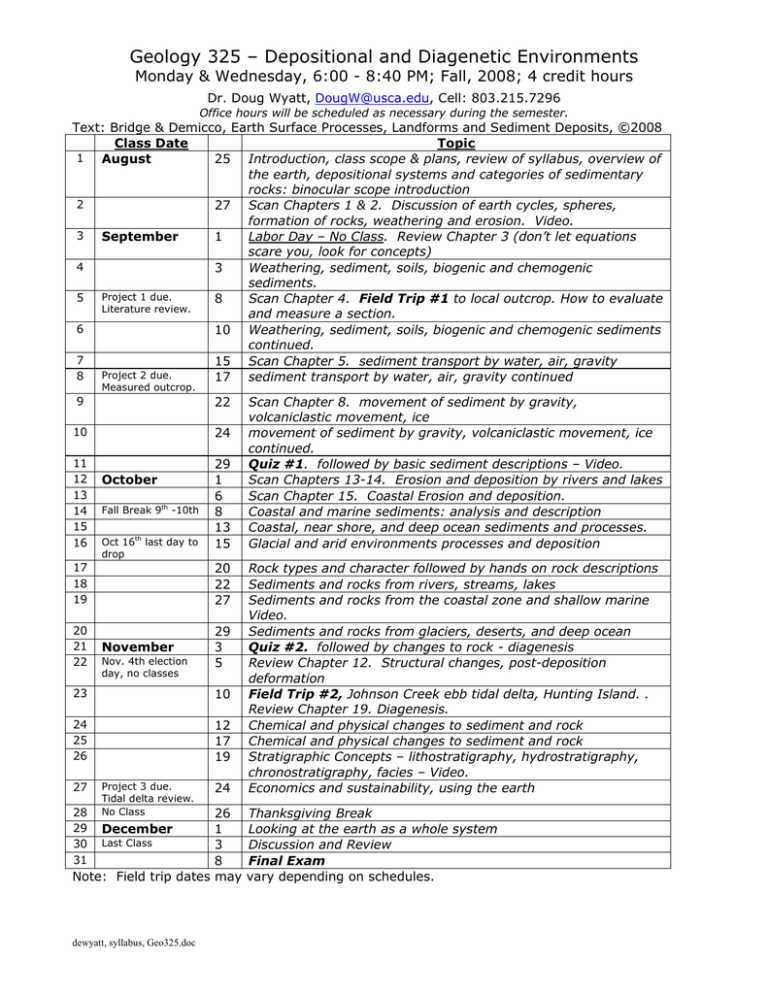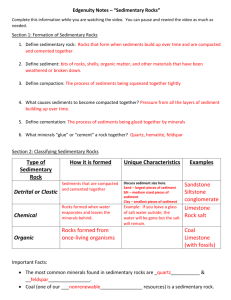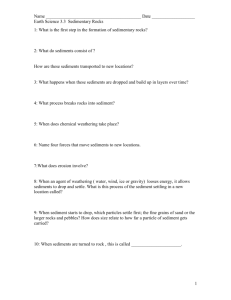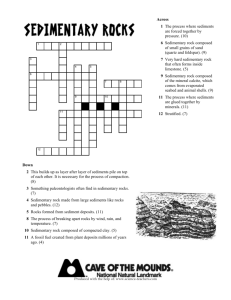Geology 325 – Depositional and Diagenetic Environments
advertisement

Geology 325 – Depositional and Diagenetic Environments Monday & Wednesday, 6:00 - 8:40 PM; Fall, 2008; 4 credit hours Dr. Doug Wyatt, DougW@usca.edu, Cell: 803.215.7296 Office hours will be scheduled as necessary during the semester. Text: Bridge & Demicco, Earth Surface Processes, Landforms and Sediment Deposits, ©2008 Class Date Topic 1 August 25 Introduction, class scope & plans, review of syllabus, overview of the earth, depositional systems and categories of sedimentary rocks: binocular scope introduction 2 27 Scan Chapters 1 & 2. Discussion of earth cycles, spheres, formation of rocks, weathering and erosion. Video. 3 September 1 Labor Day – No Class. Review Chapter 3 (don’t let equations scare you, look for concepts) 4 3 Weathering, sediment, soils, biogenic and chemogenic sediments. Project 1 due. 5 8 Scan Chapter 4. Field Trip #1 to local outcrop. How to evaluate Literature review. and measure a section. 6 10 Weathering, sediment, soils, biogenic and chemogenic sediments continued. 7 15 Scan Chapter 5. sediment transport by water, air, gravity Project 2 due. 8 17 sediment transport by water, air, gravity continued Measured outcrop. 9 22 10 24 11 12 13 14 15 16 October Fall Break 9th -10th Oct 16th last day to drop 20 22 27 17 18 19 20 21 22 29 1 6 8 13 15 November Nov. 4th election day, no classes 29 3 5 23 10 24 25 26 12 17 19 27 Project 3 due. Tidal delta review. No Class 24 26 December 1 Last Class 3 8 Note: Field trip dates may 28 29 30 31 dewyatt, syllabus, Geo325.doc Scan Chapter 8. movement of sediment by gravity, volcaniclastic movement, ice movement of sediment by gravity, volcaniclastic movement, ice continued. Quiz #1. followed by basic sediment descriptions – Video. Scan Chapters 13-14. Erosion and deposition by rivers and lakes Scan Chapter 15. Coastal Erosion and deposition. Coastal and marine sediments: analysis and description Coastal, near shore, and deep ocean sediments and processes. Glacial and arid environments processes and deposition Rock types and character followed by hands on rock descriptions Sediments and rocks from rivers, streams, lakes Sediments and rocks from the coastal zone and shallow marine Video. Sediments and rocks from glaciers, deserts, and deep ocean Quiz #2. followed by changes to rock - diagenesis Review Chapter 12. Structural changes, post-deposition deformation Field Trip #2, Johnson Creek ebb tidal delta, Hunting Island. . Review Chapter 19. Diagenesis. Chemical and physical changes to sediment and rock Chemical and physical changes to sediment and rock Stratigraphic Concepts – lithostratigraphy, hydrostratigraphy, chronostratigraphy, facies – Video. Economics and sustainability, using the earth Thanksgiving Break Looking at the earth as a whole system Discussion and Review Final Exam vary depending on schedules. Geology 325 – Depositional and Diagenetic Environments Monday & Wednesday, 6:00 - 8:40 PM; Fall, 2008; 4 credit hours Class Objectives and Information My objective for this class is for you to learn the basics of sedimentary rock depositional type and style with resulting diagenesis and why these types of rocks are important for mankind. Basic sedimentology and stratigraphy will be discussed. Field examination and hands on sample analysis will be a large part of our class activities and there will be hands-on examination of sedimentary rocks. I do not expect you to memorize or fully understand the equations used in the text. Several scientific papers and/or trade articles will be reviewed as part of this class. These papers will discuss aspects and techniques of sedimentary rock geological interpretations. Some time may be spent researching resources and data from the internet. Three interpretive projects will be completed for the class. These projects will include the use of geological concepts and techniques related to the study of sedimentary rocks. The projects will become progressively more complex during the course. Some, or all, of the projects may be collaborative efforts. The quizzes and final exam will cover key concepts discussed in class. There will be at least two field trips for this class. One will be close by and occur during the class period. The other trip will require a trip to the beach and will probably be an overnight trip. We will work to keep expenses and time to a minimum. This is a long class period and we will have a break during the class. permitted. Food and drink are If you have a physical, psychological, and/or learning disability which might affect your performance in this class, please contact the Office of Disability Services, 126A B&E, (803) 6413609, as soon as possible. The Office of Disability Services will determine appropriate accommodations based on medical documentation. Good writing and communication is valued in this course as in life. Please remember the written work you produce in this class can be included in your rising junior writing portfolio. For further information on the portfolio requirement please consult your USCA Undergraduate and Graduate Bulletin or visit Dr. Lynn Rhodes, Director of Writing Assessment or Mr. Karl Fornes, Director of the Writing Room. The Bridge and Demicco text is excellent and you will be expected to read and understand the material. If the syllabus says “Review” a certain part of the text, I expect you to read it and be conversant in the concepts. If the syllabus says “Scan” a certain part of the text, I expect you to be broadly familiar with the terms and concepts. Grading Grades will be based on completion of three (3) projects, class participation, two (2) quizzes, and a final exam. The point system used and overall grading will be based on the following: Project #1 (25 points) – literature review project Project #2 (25 points) – measured outcrop and sample descriptions Project #3 (50 points) – current deposition and tidal delta map Quiz #1 (50 points) - multiple choice, short answer, T/F, sketch Quiz #2 (50 points) - multiple choice, short answer, T/F, sketch Final (100 points) – multiple choice, short answer, T/F, sketch Participation (±10 points) – add or subtract up to 10 points in either direction, my call! Total 300 points, 275-300=A, 250-274=B, 225-249=C, 200-224=D, <200 no excuses! dewyatt, syllabus, Geo325.doc








